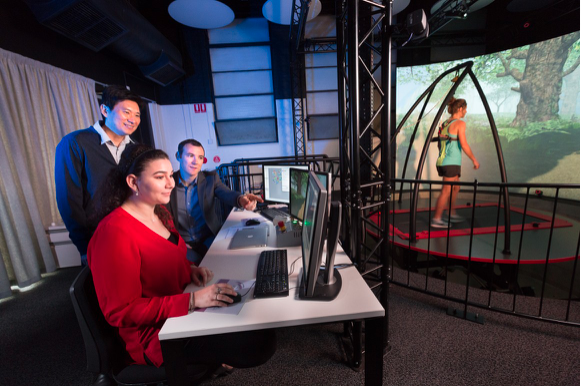Virtual Reality facility helping patients recover from injuries

The University of Melbourne is home to a new state of the art Virtual Reality (VR) biomechanical facility that is vastly improving our understanding of human movement and how to treat and prevent injuries.
Launched today by Federal Minister for Health Greg Hunt, the Computer Assisted Rehabilitation Environment (CAREN) is the only one of its kind in Australia and brings together biomechanics, computer science and neuroscience to analyse human movement and performance in real-time.
Featuring a dual belt treadmill that sits on a movable platform, surrounded by a large curved screen projecting a VR scenario, the CAREN uses sensors and motion capture cameras to create a three-dimensional computer model of a patient’s body while they walk on the treadmill (in a safety harness), indicating the amount of joint motion and muscle loading in the limbs in real-time.
Melbourne School of Engineering Dean Graham Schaffer said the CAREN is distinct from other laboratories in that it simulates a field environment.
“In a normal lab, you’re always going to walk a bit differently. You cannot move the ground and get someone to trip, whereas here you can do that in a safe environment,” Professor Schaffer said.
“The CAREN allows researchers to immerse the patient in a virtual reality environment such as a city street, forest or park, and safely make unplanned, physical perturbations to mimic real-life tripping and slipping scenarios.
"This enables us to analyse what muscles are activated, how joints function, and brain activity during movement, including the effects of mental and physical strain.”
Health Minister Greg Hunt said that Australians are set to benefit from the first CAREN laboratory in the country.
“CAREN has the potential to change lives by using advanced technology to give people back their mobility,” Minister Hunt said.
“The CAREN also demonstrates that the University of Melbourne is consistently at the forefront of research.”
University of Melbourne Acting Vice-Chancellor Mark Considine said this facility will benefit researchers from a range of different fields.
“The functionality of the CAREN is unique, and it is being used by some of the best and most advanced clinical and research facilities in the world,” Professor Considine said.
“It’s a tremendous boost for Melbourne, allowing our researchers to work more closely together on grand challenges such as ageing, rehabilitation and mental health.”
Researchers Dr David Ackland, Deputy Head of the Department of Biomedical Engineering, Professor Peter Lee from the Department of Mechanical Engineering and PhD student Raneem Haddara oversee the lab.
Dr Ackland, who studies muscle and joint function in the human body and how diseases or injury affect motor performance, said the CAREN will help him understand how patients are responding to surgery and rehabilitation.
“We can accurately evaluate how people generate joint motion pre- and post-operatively,” Dr Ackland said.
“For example, we can look at how a joint replacement is affecting a person’s ability to move a joint after surgery, or how a stroke patient’s balance and fall risk is affected by rehabilitation. The breadth of applications is endless.”